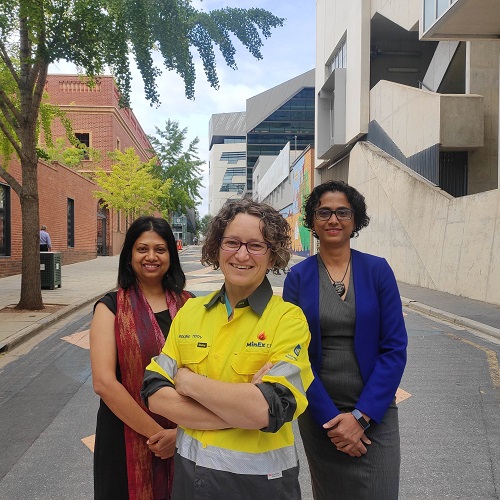08 March 2021
 Hacking through the jungle. An uphill battle. Being the Road Runner but on an ice-skating rink. These are just some of the ways a woman’s career path in geosciences is described by those working in the field.
Hacking through the jungle. An uphill battle. Being the Road Runner but on an ice-skating rink. These are just some of the ways a woman’s career path in geosciences is described by those working in the field.
The responses are part of a new University of South Australia research project that is looking at the power of perception to understand the lack of gender diversity in geosciences.
According to UniSA geoscientist Associate Professor Caroline Tiddy, more than 80 per cent of Australia’s mining workforce are male while just seven percent of professors in Earth sciences in academia are female.
Assoc Prof Tiddy is joining forces with Associate Professor Shruti Sardeshmukh and Dr Sanjee Perera to explore the role perceptions play in women’s career choices in STEM – and why so much female talent is lost in the “leaky pipeline”.
“Perceptions are so important – they are how we process information to make sense of the world around us,” Assoc Prof Tiddy says.
“They also shape how we approach our careers. By looking at gender differences in perceptions, we can get a better understanding of why gender inequality exists in geosciences – and what we can do about it.”
In an interview-based study of geoscientists from varied career levels and sectors, participants were asked to provide a visual metaphor to describe their career and then the career of the opposite gender. Initial data analysis reveals the stark contrast between male and female experiences of their geoscience careers.
“Nearly 40 per cent of men felt they ‘had achieved’ in their geosciences career yet only three per cent of women felt the same way,” Assoc Prof Tiddy says.
“Female geoscientists’ career metaphors more often contained notions of being challenging and incomplete while men frequently saw their careers as being rewarding and filled with achievements.
“Sense of achievement is critical to career satisfaction and overall enjoyment of working life. We need to find out what is missing for women.”
In addition, Assoc Prof Tiddy says women geoscientists tended to use dominating figures such as silverback gorillas and the Incredible Hulk to refer to the opposite gender while male geoscientists described women as “starting to find their voice” and “not as appreciated”.
“We are still drilling down to uncover the harm such differences in perception might be doing, but these early results suggest women are justified in feeling their career path involves more challenges than men,” she says.
“Looking at the perceptions that exist, it is no wonder girls aren’t choosing careers in the geosciences. If these relatively negative perceptions do reflect reality, it’s not surprising female talent is being lost along the way in this so-called ‘leaky pipeline’.”
According to Dr Sardeshmukh, whose research focuses on gender barriers to male-dominated sectors, diversity at strategic levels is key to organisational performance and innovation.
She says sectors become male-dominated for two reasons: women don't choose to work in those sectors in the first place or they don't stay in those careers long-term.
“Gender in STEM research often revolves around attracting women to the field, and that is important work. But it is equally important to make sure women stay and progress in their STEM careers,” Dr Sardeshmukh says.
“Women's career journeys in STEM appear to be more onerous and uphill than men's paths, which our initial analysis of perceptions clearly shows. Our early findings indicate the challenges women face relate to the job characteristics and workplace culture.
“As we continue our project, we hope to find tangible ways to improve workplace culture and in turn, shift perceptions and boost gender diversity in geosciences and hopefully in STEM more broadly.”
Media contact: Rosanna Galvin T: +61 8 8302 0578 M: +61 434 603 457 E: rosanna.galvin@unisa.edu.au



